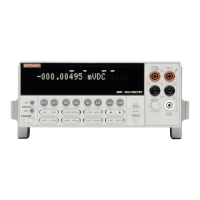IEEE-488 Reference
4-149
4.19.13 :DETector commands
:FUNCTION] <name>
[:SENSe[1]]:CURRent:AC:DETector[:FUNCTION] <name> Specify detector for ACI
[:SENSe[1]]:VOLTage:AC:DETector[:FUNCTION] <name> Specify detector for ACV
Parameters ACI:
<name> = RMS AC RMS amps measurements
= AVERage AC average amps measurements
ACV:
<name> = RMS AC RMS volts measurements
= AVERage AC average volts measurements
= LFRMs Low frequency AC volts measurements
= PEAK AC peak volts measurements
= NPEak DC negative peak spike volts measurements
= PPEak AC positive peak spike volts measurements
Formats :curr:ac:det <name>
:volt:ac:det <name>
Defaults Power-up Saved power-on setup
*RST RMS (ACI and ACV)
:SYSTem:PRESet RMS (ACI and ACV)
Query :FUNCtion]? Query selected measurement type
Short-form formats: :curr:ac:det?
:volt:ac:det?
Response message: RMS, AVER, LFRM, PEAK, NPE or PPE
Description These commands are used to select the measurement type for the ACI and ACV functions.
For ACI, use AVERage to make AC average (0.636 of peak) current measurements, and use the
RMS parameter to make RMS current measurements.
For ACV, use AVERage to make AC average (0.636 of peak) current measurements. Use the
RMS parameter to make RMS current measurements above 100Hz. To make low frequency
RMS measurements below 50Hz, use the LFRMs parameter. For measurements between 50Hz
and 100Hz, you can use either LFRMs or RMS. However, keep in mind that LFRMs measure-
ments are slower.
The PEAK selection allows you to make peak measurements. For this type of measurement, the
instrument will measure the largest peak (positive or negative) for each measurement
conversion.
PSPike and NSPike allows you to measure positive or negative peak spikes. The sampling period
for each reading is controlled by :PWINdow. Note that a peak spike measurement is considered
a DCV measurement even though it is performed on the ACV function (see DCV PEAK
SPIKES MEASUREMENT in the specifications).

